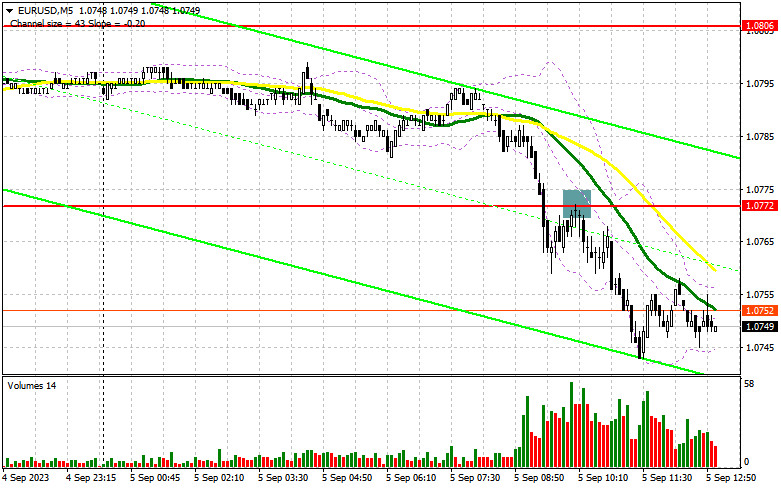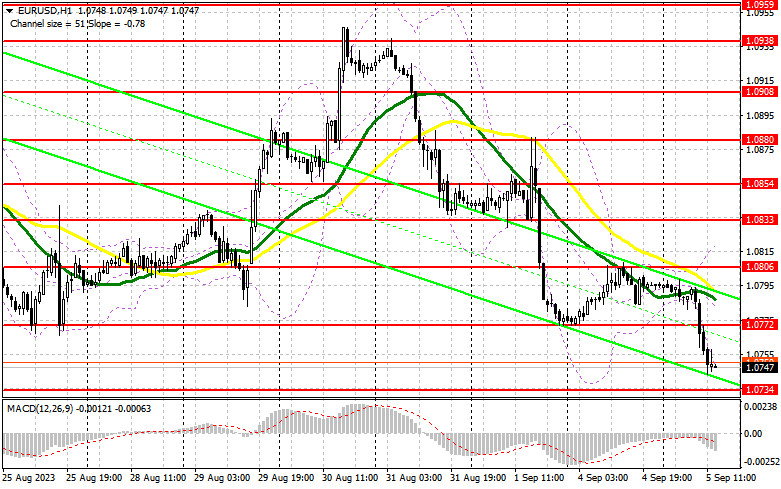
In my morning forecast, I drew attention to the level of 1.0772 and recommended making trading decisions based on it. Let's look at the 5-minute chart and analyze what happened there. The breakout and subsequent retest of this range from bottom to top resulted in a selling signal, leading to a significant drop in the pair by more than 30 points. The technical picture remained unchanged for the second half of the day.

To open long positions on EUR/USD, the following conditions are required:
Anticipated weak data on activity indices in the eurozone services sector and their downward revision for August have all contributed to a new decline in the euro. I pointed this out in my morning forecast and recommended selling EUR/USD. Considering that only figures on changes in manufacturing orders in the US and the IBD/TIPP Economic Optimism Index are expected in the second half of the day, it is unlikely that euro buyers will be able to use this data to compensate for any part of the pair's decline.
I plan to act after the nearest support at 1.0734 is updated. Forming a false breakout at this level will signal a buying opportunity for the euro with a rebound target of 1.0772. This area now serves as resistance that buyers need to reclaim if they plan anything for today. A breakout and retest of 1.0772 from top to bottom, against the backdrop of very weak US data and hawkish statements from European politicians, will boost demand for the euro, providing an opportunity to rise to 1.0806, where the moving averages are located, favoring the sellers. The ultimate target will be around 1.0833, where I will take profits. The bears will maintain market control if further EUR/USD declines and inactivity at 1.0734 in the second half of the day. In such a scenario, only a false breakout around 1.0705 will provide a buy signal for the euro. I will consider opening long positions from a rebound starting at 1.0669 with a target of a 30-35 point intraday upward trend correction.

To open short positions on EUR/USD, the following conditions are required:
Sellers have dealt with all the tasks and are now focused on 1.0734. But even more important is the ability to maintain trading below 1.0772. The cautious tone of European politicians heard yesterday will allow the bears to defend 1.0772 in the event of a pair's rise in the second half of the day. A false breakout, similar to the one I discussed earlier, will signal a sale, opening the way to the support area at 1.0734. Only after breaking through and consolidating below this range, as well as a retest from bottom to top, do I expect to receive another sell signal targeting 1.0705, where I anticipate the presence of larger buyers. The ultimate target will be around 1.0669, where I will take profits. In the event of an upward move in EUR/USD during the American session and the absence of bears at 1.0772, the bulls will attempt to compensate for the morning decline and stop the bearish market, although this is unlikely. In such a scenario, I will postpone short positions until the resistance at 1.0806. Selling is also possible there, but only after an unsuccessful consolidation. I will consider opening short positions from a rebound starting at 1.0833, targeting a 30-35 point downward trend correction.
The COT (Commitment of Traders) report for August 29th showed a reduction in long positions and an increase in short positions. Such market changes reflect the hawkish comments made by Federal Reserve Chairman Jerome Powell at the Jackson Hole Symposium. Recent data on US personal consumption expenditures and the labor market have once again convinced investors that the Fed will need to raise interest rates, which has maintained the attractiveness of the US dollar. However, paradoxically, the decline in the euro is quite an interesting development, and in the current conditions, the optimal medium-term strategy remains to buy risk assets on the decline. The COT report indicates that non-commercial long positions decreased by 8,849 to 230,542, while non-commercial short positions increased by 3,232 to 83,863. As a result, the spread between long and short positions increased by 4,753. The closing price dropped to 1.0882 from 1.0866, indicating a bearish market.
Indicator Signals:
Moving Averages
Trading is below the 30 and 50-day moving averages, indicating a bearish market.
Note: The period and prices of the moving averages discussed by the author are on the hourly H1 chart and differ from the general definition of classic daily moving averages on the daily D1 chart.
Bollinger Bands
In the case of an uptrend, the upper boundary of the indicator will act as resistance around 1.0815.
Indicator Descriptions:
Moving Average (determines the current trend by smoothing volatility and noise). Period 50. Marked in yellow on the chart.Moving Average (determines the current trend by smoothing volatility and noise). Period 30. Marked in green on the chart.MACD Indicator (Moving Average Convergence/Divergence). Fast EMA period 12. Slow EMA period 26. SMA period 9.Bollinger Bands (Bollinger Bands). Period 20.Non-commercial traders are speculators such as individual traders, hedge funds, and large institutions using the futures market for speculative purposes and meeting certain requirements.Long non-commercial positions represent the total long open positions of non-commercial traders.Short non-commercial positions represent the total short open positions of non-commercial traders.The net non-commercial position is the difference between non-commercial traders' short and long positions.